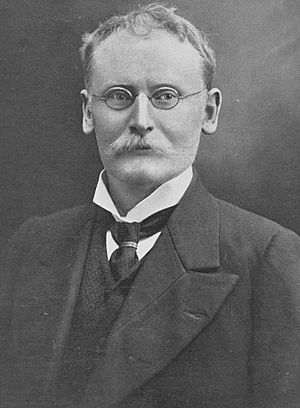William Hall-Jones facts for kids
Quick facts for kids
Sir William Hall-Jones
|
|
|---|---|
 |
|
| 16th Prime Minister of New Zealand | |
| In office 10 June 1906 – 6 August 1906 |
|
| Monarch | Edward VII |
| Governor | William Plunket |
| Preceded by | Richard Seddon |
| Succeeded by | Joseph Ward |
| Constituency | Timaru |
| 2nd High Commissioner to the United Kingdom | |
| In office 1908–1912 |
|
| Preceded by | William Pember Reeves |
| Succeeded by | Thomas Mackenzie |
| Personal details | |
| Born | 16 January 1851 Folkestone, Kent, England |
| Died | 19 June 1936 (aged 85) Wellington, New Zealand |
| Political party | Liberal |
| Spouses |
Fanny Smith
(m. 1873; died 1876)Rosalind Lucy Purss
(m. 1877) |
| Children | Fred Hall-Jones |
| Relatives | John Hall-Jones (grandson) |
| Signature | |
Sir William Hall-Jones (born 16 January 1851 – died 19 June 1936) was a very important person in New Zealand's history. He was the 16th prime minister for a short time in 1906.
He first became a Member of Parliament in 1890. Later, he joined the Liberal Party. Sir William was a temporary prime minister after the death of Richard Seddon. He held the role until Joseph Ward returned to New Zealand from overseas.
People knew Hall-Jones as a calm and excellent leader. Prime Minister Seddon once said he was the "best administrator" in his team. From 1908 to 1912, Hall-Jones also served as New Zealand's High Commissioner in the United Kingdom.
Contents
Early Life and Career
William Hall-Jones was born in Folkestone, England. He moved to New Zealand in 1873, arriving in Dunedin. He started his career as a carpenter and later became a builder in Timaru.
He became interested in local government. He served on the Timaru Borough Council from 1884 to 1886. He was also on the council again from 1890 to 1892.
Becoming a Member of Parliament
| New Zealand Parliament | ||||
| Years | Term | Electorate | Party | |
| 1890 | 10th | Timaru | Independent Liberal | |
| 1890–1893 | 11th | Timaru | Independent Liberal | |
| 1893–1896 | 12th | Timaru | Independent Liberal | |
| 1896–1899 | 13th | Timaru | Liberal | |
| 1899–1902 | 14th | Timaru | Liberal | |
| 1902–1905 | 15th | Timaru | Liberal | |
| 1905–1908 | 16th | Timaru | Liberal | |
In 1890, a special election was held in the Timaru area. This happened after the death of Richard Turnbull. Hall-Jones won this election on 18 August 1890.
At first, he did not want to run for Parliament. He had many business projects planned. But people kept asking him, so he agreed, even though he had no big plans to be a politician. He represented Timaru in the House of Representatives until he left in October 1908.
Hall-Jones was known for thinking for himself. He started as an Independent Liberal. His ideas were modern and progressive. He often agreed with leaders like John Ballance and Sir George Grey. In 1891, he joined the Liberal Party and became a party whip.
Becoming a Cabinet Minister
In March 1896, Hall-Jones became a cabinet minister. Prime Minister Richard Seddon gave him the job of Public Works. This happened after William Pember Reeves left to work for New Zealand in the United Kingdom.
One of Hall-Jones's main jobs was to improve the main railway line. This line connected Auckland and Wellington. He chose a better route for the railway, which led to the building of the Raurimu Spiral. He also helped make sure the Otira tunnel was built through Arthur's Pass.
A few weeks after joining the cabinet, Hall-Jones also became the Minister of Marine. He held this job for more than ten years. He helped pass a law to protect Pelorus Jack, a famous dolphin. This law was passed in 1904.
Serving as Prime Minister
In 1906, Hall-Jones was the acting prime minister when Seddon was away. After Seddon's funeral, he officially became prime minister. His time as prime minister was very short.
During this time, he held many important roles. He was the Colonial Treasurer, Minister of Labour, Minister of Education, Minister for Public Works, and Minister of Marine.
Hall-Jones said he would only be prime minister until Sir Joseph Ward returned from overseas. Even so, many people wondered if he might try to stay in power.
Later Career and Legacy
After his time as prime minister, Hall-Jones continued to serve. He took on the Railways and Public Works jobs in the new government led by Ward.
In December 1908, he became the High Commissioner for New Zealand in London. He took over from William Pember Reeves. When his term ended in 1912, he returned to New Zealand. Massey then appointed him to the Legislative Council.
Sir William Hall-Jones passed away at his home in Wellington on 19 June 1936.
See also

